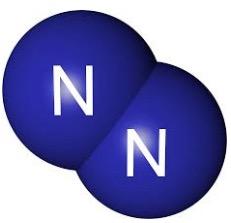I've written before about what happens when prisons use bad science to carry out capital punishment (1). It's not pretty. Arguably, the worst offender has been the state of Oklahoma, which brutally botched a series of executions because of a profound ignorance of pharmacology (2). So it is a bit ironic that Oklahoma is the first state to get the science right (3). The state is formulating plans for using nitrogen asphyxiation for capital punishment. It shouldn't have taken so long because the science behind what Oklahoma is proposing is well-known and the science is sound. Nitrogen asphyxiation, if done properly, should be painless and effective (4). At the very least it will be a more humane alternative to previous attempts by the state, which were death by torture.
Oklahoma didn't discover anything that suicide rights advocacy groups haven't known for years - that the use of an inert gas (5) to displace of oxygen from the body is an effective, albeit imperfect method for committing suicide which has become increasingly common in recent years. There is information about helium asphyxiation all over the Internet. People have been using helium instead of nitrogen because of the ease of obtaining helium tanks from party stores or even online. Helium is used to make a "suicide bag," which was described by journalist Derek Humphry in his highly controversial book 1991 book "Final Exit: The Practicalities of Self-Deliverance and Assisted Suicide for the Dying" (6).
The physiology of why death by asphyxiation can be either torturous or painless is quite interesting. When people try to hold their breath or are strangled or choking is triggered gasping for breath is automatic. This is a horrible way to die. But this response does not, as is commonly believed, happen because of deprivation of oxygen. Rather, it is the body's reflexive way of trying to expel carbon dioxide in order to maintain pH of the blood (7). When carbon dioxide is in solution it forms a small amount of carbonic acid, which is, as the name suggests, acidic. The body needs to expel the gas in order to prevent carbonic acid from building up and acidifying the blood.
The gasping reflex is not triggered in this case because breathing continues, allowing carbon dioxide to be expelled with each breath. When people breathe pure helium loss of consciousness occurs within 10-15 seconds. Other sources report slightly longer times. People go to sleep and don't wake up. This is what Oklahoma is proposing - a sedative and then a mask, which, by any measure, is far more humane than hydrogen cyanide, which was the poison used in gas chambers.
Here are a few other factoids about asphyxiation by inert gas:
- Helium has been the "gas of choice" of people who want to end their lives but helium suppliers have caught on, so now most disposable tanks of helium now contain 20% air, which will still make balloons rise, but contains enough oxygen to prevent death.
- Both nitrogen and argon are "better" choices than helium because they are denser, which makes them better at displacing oxygen.
- Because it is so light and small helium escapes balloon (7) readily. But nitrogen and argon are better at displacing oxygen because they are much denser but harder to get. Very large tanks of pure nitrogen can be obtained at welding supply stores.
- Other gases, for example, carbon monoxide and hydrogen cyanide also kill by depleting the brain of oxygen, but these are highly toxic and make you very sick before death.
NOTES:
(1) My opinion about whether capital punishment is right or wrong is irrelevant. I am commenting only on the chemistry and pharmacology of the methods used, especially since lethal injection drugs have become impossible for prisons to get.
(2) See: "Chemistry, Politics, And The Death Penalty" and Arkansas Has An Alternative Lethal Injection? Dead Wrong
(3) Mississippi has legalized execution by nitrogen but has not used it.
(4) "Properly" refers to how the inert gas is administered. If pure helium is inhaled unconsciousness occurs in 15-30 seconds, and death in minutes. Other sources cite slightly longer times. The key to a humane execution by asphyxiation is to insure that no oxygen is being taken in. If low levels of oxygen are present this prolongs the times of unconsciousness and death and can cause considerable suffering.
(5) Inert gases aka "noble gases" are chemically unreactive and non-toxic. Nitrogen is technically not in this class, but for all practical purposes, it can be. The naturally occurring noble gases are helium, neon, argon, krypton, xenon, and radon, which is radioactive. Only the first three have any practical applications. The others are rare and expensive.
(6) The pH of blood is tightly regulated by the body. The range of the pH of blood under normal circumstances is 7.32-7.42. When the pH drops below 7.35 acidosis, which can be quickly lethal, occurs. Metabolic acidosis results from ketones (technically keto acids) formed, usually in diabetics, when blood glucose levels become too high. Respiratory acidosis results from the inability to expel carbon dioxide. Although both cause the same effect the causes are very different.
(6) Helium was not mentioned in "Final Exit." It was added to Humphry's "Supplement to Final Exit" (2000).
(7) Helium-filled balloons deflate because helium has the smallest atomic radius (even smaller than hydrogen). This enables it to pass through the latex (leaving behind air) because helium is smaller than the pores of the latex. It doesn't matter how tightly the balloon is sealed.




